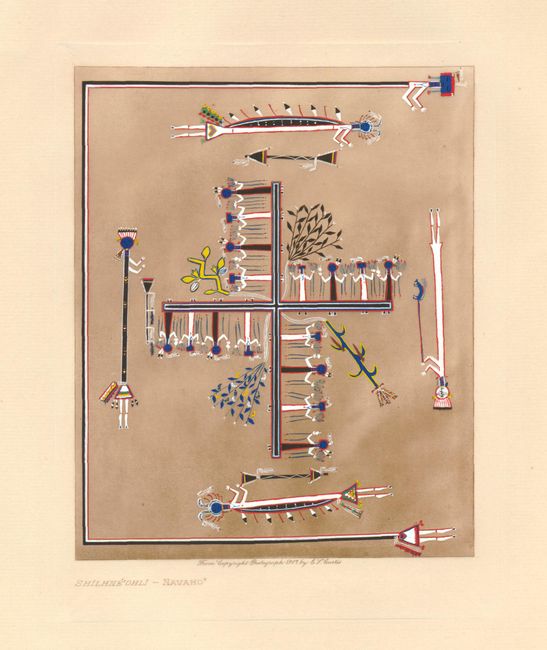Subject: Prints Native American
Period: 1907 (dated)
Publication: The North American Indian
Color: Hand Color
Size:
5.5 x 7.2 inches
14 x 18.3 cm
This is an exquisite and rare hand colored photogravure from Curtis' monumental work. This volume plate was always hand colored, one of the few thus finished as most were left in uncolored sepia tones. The North American Indian was published in twenty volumes and accompanying portfolios with less than 300 complete sets published. The gravures were printed on three fine papers depending on the preference of the subscriber: Dutch Van Gelder, Vellum and Japanese Tissue, the rarest. This image is on tissue which was always mounted at the corners on a larger piece of the softer Van Gelder. The tissue gravures provide a luminescence not possible on the two other papers. A lovely example of this image.
Edward S. Curtis was born near Whitewater, Wisconsin in 1868. His early fascination with the camera and appreciation of the North American Indian led to the life long obsession of documenting their culture. In about 1900, he realized that the passing of every old man and woman meant the risk of losing forever the knowledge of sacred rites and traditions. His most famous image, "The Vanishing Race", best symbolizes his compassion for the Indian people and the urgency he attached to creating a record of their unique culture.
He developed a plan to publish, in twenty volumes, a complete photographic and written history of every major tribe in North America. His friendship with such influential people as Teddy Roosevelt and E.H. Harriman led to an introduction to J.P. Morgan to acquire financial backing for the publication. For the next quarter century Curtis dedicated his life to the project. With the publication of the first two volumes in 1907-8 The New York Herald hailed it as "the most gigantic undertaking in the making of books since the King James edition of the Bible." We are indebted to Curtis' wisdom and dedication for bringing these magnificent images, and the culture they represent, to light.
Tone photogravures are produced by the intaglio process, which is Italian for incising or engraving. First developed about 1880, this process produced the most brilliant and faithful monochrome images yet known in the history of printing. To make the image, a finely etched copper plate is produced from a photographic positive. In practice, this involved exposing a light-sensitive sheet of gelatin through the photographic positive and then washing the sheet in a warm water bath. This left the gelatin thinner in the darker areas and thicker in the light area. The gelatin was then laid on the copper plate and submerged in an acid bath for etching. The thinner areas of the gelatin allowed the acid to act, more or less fully, on the plate producing a deep etch capable of holding more ink and therefore printing darker. The variable thickness of the gelatin sheet resulted in a broad, and very accurate, range of tones in the final print. The print was then made from the copper plate in the traditional intaglio method by filling the etched areas with ink, and then transferring the image under immense pressure from the copper plate to the paper. The paper was slightly moistened prior to printing to force the paper into the etched areas; drawing out the ink to exactly match the tone of the photograph.
References:
Condition: A+
Mint example with all four corners attached to the underlying Van Gelder with no corner tears, uncommon in these delicate tissue images.


